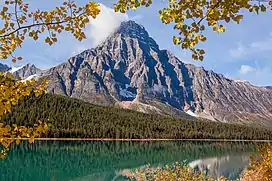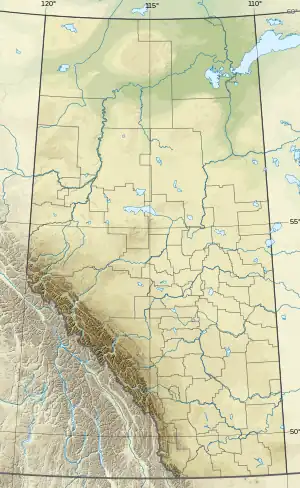Mount Chephren
Mount Chephren is a mountain located in the Mistaya River Valley of Banff National Park, Canada.
| Mount Chephren | |
|---|---|
 Mount Chephren and Waterfowl Lake seen from the Icefields Parkway | |
| Highest point | |
| Elevation | 3,266 m (10,715 ft)[1][2][3]: 306 [lower-alpha 1] |
| Prominence | 443 m (1,453 ft)[5][lower-alpha 2] |
| Parent peak | Howse Peak (3295 m)[5] |
| Listing | Mountains of Alberta |
| Coordinates | 51°50′25″N 116°40′59″W[7] |
| Geography | |
 Mount Chephren Location in Alberta | |
| Location | Alberta, Canada |
| Parent range | Waputik Mountains |
| Topo map | NTS 82N15 Mistaya Lake |
| Geology | |
| Type of rock | Quartzite, Limestone, Dolomite[3]: 306 |
| Climbing | |
| First ascent | 1913 by J.W.A. Hickson, guided by Edward Feuz jr.[2] |
| Easiest route | Scramble (difficult) on south face |
Mount Chephren was named after Chephren, the 4th Dynasty Egyptian pharaoh. The mountain was originally named Pyramid Mountain in 1897 by J. Norman Collie, but it conflicted with an identically named peak in Jasper National Park, so it was renamed in 1924 to its present name.[8][4][2]
Routes
Scramble
Mount Chephren is rated a difficult scramble on the south face due to its steep upper slopes with possible snow and ice difficulties. Considerable snow on the route would likely require crampons and an ice axe, thereby pushing the climb into the realm of technical mountaineering. The best conditions for scrambling would normally be late July and August.[4]
The trail head is located at the west end of the Waterfowl Lakes campground off the Icefields Parkway in Banff National Park. The elevation gain from the trail head to the summit is 1,630 m (5,348 ft).[4]
Geology
Like other mountains in Banff Park, Mount Chephren is composed of sedimentary rock laid down during the Precambrian to Jurassic periods.[10] Formed in shallow seas, this sedimentary rock was pushed east and over the top of younger rock during the Laramide orogeny.[11]
Climate
Based on the Köppen climate classification, Mount Chephren is located in a subarctic climate zone with cold, snowy winters, and mild summers.[12] Winter temperatures can drop below −20 °C with wind chill factors below −30 °C.

References
- Bow Lake and Saskatchewan Crossing (Map). Cochrane, AB: Gem Trek Publishing. 1995. ISBN 1-895526-10-8. Retrieved 2021-06-13.
- "Mount Chephren". cdnrockiesdatabases.ca. Retrieved 2003-11-08.
- Gadd, Ben (2008). Canadian Rockies Geology Road Tours. Jasper, AB: Corax Press. ISBN 978-0-9692631-2-8.
- Kane, Alan (1999). Scrambles in the Canadian Rockies. Calgary: Rocky Mountain Books. pp. 300–301. ISBN 0-921102-67-4.
- "Mount Chephren". Bivouac.com. Retrieved 2013-05-18.
- "Mount Chephren". Peakbagger.com. Retrieved 2021-06-13.
- "Mount Chephren". Geographical Names Data Base. Natural Resources Canada. Retrieved 2013-05-18.
- "Official naming date". Natural Resources Canada. Retrieved 2019-05-07.
- Dougherty, Sean (1991). Selected Alpine Climbs in the Canadian Rockies. Rocky Mountain Books. p. 174. ISBN 9780921102144.
- Belyea, Helen R. (1960). The Story of the Mountains in Banff National Park (PDF). parkscanadahistory.com (Report). Ottawa: Geological Survey of Canada. Archived (PDF) from the original on 2015-10-02. Retrieved 2019-09-13.
- Gadd, Ben (2008). Geology of the Rocky Mountains and Columbias.
- Peel, M. C.; Finlayson, B. L.; McMahon, T. A. (2007). "Updated world map of the Köppen−Geiger climate classification". Hydrol. Earth Syst. Sci. 11: 1633–1644. ISSN 1027-5606.
- Notes